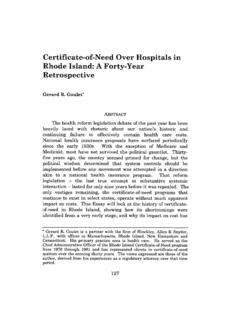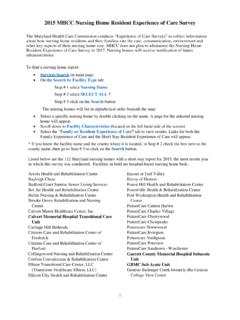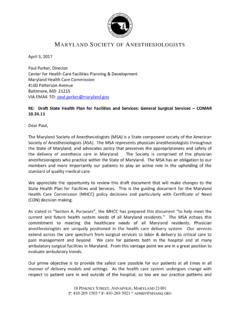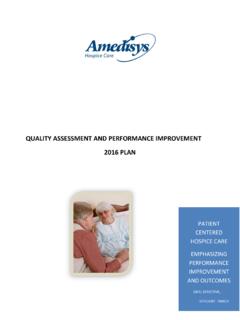Transcription of Travel Distance and Health Outcomes for Scheduled Surgery
1 ORIGINAL ARTICLE. Travel Distance and Health Outcomes for Scheduled Surgery ShinYi Chou, PhD,*w Mary E. Deily, PhD,* and Suhui Li, PhDz Background: Changes in the location and availability of surgical services change the distances that patients must Travel for Surgery . C hanges in the location and availability of surgical services change the distances that patients must Travel for Surgery . For example, regionalizing surgical programs or Identifying Health effects related to Travel Distance is therefore adopting volume-based referral practices so that patients go crucial to evaluating policies that affect the geographic distribution to higher-volume centers for Surgery would increase the of these services.
2 We examine the Health Outcomes of coronary distances many 3 Conversely, removing regulatory artery bypass graft (CABG) patients in Pennsylvania for evidence barriers limiting entry of new surgical programs would de- that traveling further to a hospital for a one-time, Scheduled surgical crease Travel distances if more providers enter the procedure causes harm. Identifying Health effects related to Travel Distance is there- Methods: We perform instrumental-variable regressions to test for fore crucial to evaluating policies that affect the geographic the effect of Distance to the admitting hospital on the in-hospital distribution of surgical services, but the causal relationship mortality and readmission rates of 102,858 CABG patients in is difficult to identify because confounding factors such as Pennsylvania during 1995 2005.
3 Where the instrumental variables patients' behavioral patterns and the quality of admitting are constructed based on the quality of and Distance to nearby hospitals are likely correlated with both Travel Distance and CABG hospitals. surgical Outcomes . In this paper, we use a novel set of in- strumental variables to determine whether Travel Distance results : We found that patients living near a CABG hospital with affects Health Outcomes of patients having Scheduled coro- acceptable quality traveled significantly less and if they were high- nary artery bypass graft (CABG) Surgery in Pennsylvania risk, had lower in-hospital mortality rates.
4 Readmission rates in during the period 1995 2005. general are not affected by patients' Travel Distance . Travel Distance may most obviously affect Health Discussion: The positive correlation between Travel Distance and Outcomes if it reduces utilization of preventive care or delays Health Outcomes observed by previous studies may reflect the care in emergency ,6 However, for one-time, confounding effects of behavioral factors and patient Health risks. nonemergent surgical patients, greater distances may result We found instead that living further from the admitting hospital in worse Health Outcomes if they delay preoperative proce- increases in-hospital mortality for high-risk CABG patients.
5 More dures, impair preoperative education of patients and families, research on the possible causes of these effects is necessary to reduce the amount of informal care provided by families, or identify optimal policy responses. reduce the continuity of postoperative care. Prior literature reveals that preoperative education and family support de- Key Words: Travel Distance , Scheduled Surgery , hospital quality, crease patients' emotional stress, reduce deterioration of Outcomes , CABG, regionalization, United States patients' functional and psychological status during the (Med Care 2014;52: 250 257) perioperative waiting period, and decrease postoperative ,8 The benefits of preoperative preparation may be particularly important for high-risk patients: pre- operative intensive inspiratory muscle training, for example, From the *Department of Economic, Lehigh University, Bethlehem, PA; can prevent postoperative pulmonary complications in high- wNational Bureau of Economic Research, Cambridge, MA; and zDepartment of Health Policy, School of Public Health and Health risk patients undergoing CABG Services, The George Washington University, Washington, DC.
6 However, identifying the causal relationship between Supported by the Lehigh University College of Business & Economics, the Travel Distance and Health Outcomes is difficult because un- Lehigh University Martindale Center for Private Enterprise, and the observed preferences and characteristics of patients may be Pennsylvania Department of Health (CURE Grant SAP Number correlated with both Travel Distance and Health Outcomes . For 4100054856). This analysis was carried out by C., , and S. L. PHC4, its agents and staff, bear no responsibility or liability for the example, patients may Travel further because they have a results of the analysis, which are solely the opinion of the authors.
7 Stronger will to live that helps them achieve better Outcomes , The authors declare no conflict of interest. or they do so to be treated at centers of excellence and thus Reprints: Suhui Li, PhD, Department of Health Policy, School of Public experience better 13 In contrast, patients trav- Health and Health Services, The George Washington University, 2021 K. St., Suite 800, Washington, DC 20006 (e-mail: eling further to seek better hospitals may be sicker and, thus, Copyright r 2013 by Lippincott Williams & Wilkins experience worse If, as we hypothesize, the ISSN: 0025-7079/14/5203-0250 true effect of greater Travel Distance is to cause harm, then 250 | Medical Care Volume 52, Number 3, March 2014.)
8 Medical Care Volume 52, Number 3, March 2014 Travel Distance and Surgical Outcomes regressing Outcomes on Travel Distance results in coefficients Outcome Equation that underestimate the true effect in the former case, biasing Our main specification is: estimates toward zero, and overestimate the true effect in . P Outcomeijkt a b1 Travel Distanceijkt b2 Pijkt . the latter case, biasing estimates away from zero. Identi- 1 . fication is further complicated because Travel Distance is b3 AHkt Hk Yt Eijkt often measured with error, which will bias estimates toward where i is an individual patient residing in zip code j and zero.
9 Undergoing s at admitting hospital k in year t, Pijkt and AHkt We address these identification problems using a novel are vectors of patient and admitting-hospital characteristics, instrumental-variable approach that controls for potentially Hk and Yt are fixed effects for admitting hospital (67 dum- confounding factors and for measurement Our in- mies) and year (10 dummies), and Eijkt is the error term. strumental variables are based on the availability and quality We estimate the effect of Travel Distance on 2 different of hospitals near a patient's home because of evidence Health Outcomes , in-hospital mortality and readmission.
10 For showing that hospital patients strongly prefer to minimize mortality, Outcomeijkt is a dummy variable that equals one if their Travel Distance but also care about 18 As pa- the patient died in the hospital, and 0 if not. For readmission, tients value both hospital quality and less Travel , the Distance Outcomeijkt is a dummy variable that equals 1 if the patient that patients actually Travel will be correlated with the quality was readmitted to any hospital during the 12 months fol- of nearby hospitals, but the quality of nearby hospitals will lowing the quarter of their CABG Surgery with a diagnosis of have no direct effect on patients' Outcomes at their admitting ischemic heart disease, congestive heart failure, or post- hospitals.










